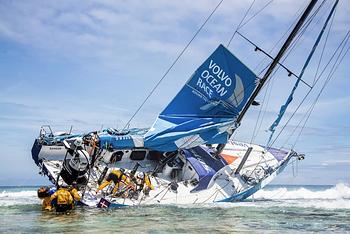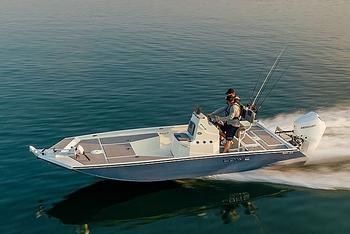You could say the debate has raged for decades whether a two-hulled pontoon or a three-hulled tritoon is better, but the truth is, there’s not much debate. The tritoon is a better boat but it is typically heavier and you’ll spend more to own one.
Pontoon boats were originally launched in the 1960s as simple freshwater boats with two aluminum floats or tubes supporting a wide, flat deck. Their catamaran-style structure was modified in the 1980s by some builders to include three tubes instead of two in an effort to boost stability and performance. This new design became known as the tritoon, and it quickly gained advocates for a number of good reasons.
Yet the original pontoon style with two floats remains a viable option for several good reasons. And many builders will offer the same models with either two floats or three, and with floats of different diameters, often 25” or 27”. Let’s take a closer look:
Advantages of a Tritoon vs. a Pontoon
When comparing tritoon and pontoon boats, the tritoon style outshines the pontoon style in several ways.
For example, the third tube increases buoyancy, improving load-carrying capacity, allowing tritoons to carry more people. Tritoons can also be wider and longer as a result, typically running to a length of 22 to 28 feet, sometimes even 30. And the largest models have much greater passenger capacity, even up to 21 people. Pontoon models are more often 16 to 25 feet in length and have a maximum passenger capacity of only eight people.
This also means that tritoons can handle higher horsepower engines, up to 300hp on some models, and carry the additional fuel that’s required. Equally important, the middle hull on a tritoon is usually set slightly lower than the other two, which often helps the boat lean into turns at higher speeds.
The extra tube gives the tritoon more stability than a pontoon, particularly at speed. Along with the tritoon’s higher buoyancy, the larger size and additional weight provides a steadier ride in stronger winds and maneuvering through waves and boat wakes.
As larger vessels, tritoons also are apt to have more storage space and other amenities. Some manufacturers offer other high-end features on their tritoon models, like arches or towers, for tritoons.
Advantages of a Pontoon vs. a Tritoon
On the other side of the coin, the pontoon has some advantages as well. One of the biggest is that having two tubes instead of three makes pontoon boats lighter than tritoons for a given overall length. For example, a Harris Sunliner 230 weighs about 2,500 pounds in a pontoon configuration while a tritoon version of the same boat weighs over 2800 pounds.
Having a smaller size and lighter weight means pontoons are easier to launch from and haul out onto a trailer. Pontoons are easier to trailer and transport behind many larger cars and light trucks, while the larger weight and scale of a tritoon may require a more powerful tow vehicle.
Pontoons are great for quiet cruising, relaxing on the water, and fishing in relatively calm waters. If that’s how you intend to use the boat, there is no need to pay for the additional features that come standard on a tritoon. Having two tubes instead of three is also better in shallow water, as they typically have less draft and more less likely to scrape the bottom.
When it comes to performance, pontoon performance can be upgraded with different types of tube shapes and diameters designed to enhance load-carrying and handling and/or to decrease drag. There are also performance packages that can make a pontoon with lifting strakes vs. a tritoon a closer matchup. Pontoons may also have less wetted surface and therefore maneuver more easily at low speeds and in tight spaces such as in a marina.

Tritoon vs. Pontoon: Power and Speed
While there are certainly some fast pontoon boats on the market today, the average tritoon can handle more and bigger engines with greater horsepower, and sometimes that means more than one engine! The result is that tritoons are often faster than their pontoon cousins. The additional stability provided by having a third float also allows the boat to have bigger engines with more horsepower.
The differences between the standard engines on both types of boats are significant. The average tritoon is powered by an engine that can reach 250 horsepower or 300 horsepower, while many pontoon engines only reach 25 to 75 horsepower.
Having three tubes also gives builders the option of mounting multiple engines, where a pontoon typically has only one. This can give the boat a top speed over 40 mph and more than enough power to tow skiers and wakeboarders. The three tubes also help the boat carve a turn at higher speed.
Pontoon vs. Tritoon: Wave Conditions
Pontoons were originally designed for calmer waters, while tritoons quickly became valued for capability in rougher, choppier water. Having three tubes on a tritoon helps stabilize the platform in modest waves and improves the ride, although even a tritoon doesn’t ride well in large waves. Nevertheless, a pontoon boat can get into serious trouble if the waves are higher than two feet.
Tritoons also maneuver better in rough water than pontoons. With the lower center float, a tritoon cuts through choppy water more easily, and its more powerful engines help propel the boat more forcefully. When the wind kicks up a chop, tritoons are both more comfortable and more capable.

Harris Grand Mariner 250. Photo credit: Harris Boats
Pontoon vs. Tritoon: Costs
One area where the pontoon beats the tritoon is cost. While both pontoons and tritoons come at a variety of price points, the initial cost of a tritoon is roughly $10,000 higher than that of a comparable pontoon. The average price of a pontoon ranges from $20,000 to $40,000, while the average price of a tritoon is about $10,000 more. Adding additional features will push the price even higher.
Pontoons also require less fuel and less storage space than tritoons, lowering operating expense to keep and operate pontoons. Maintenance costs for pontoons are also lower because there are fewer features to maintain. The maintenance costs of keeping the more powerful engines on a tritoon working properly can also increase the amount you are spending on the boat. Finally, transporting tritoons requires more expensive trailers and more powerful vehicles to compensate for the heavier weight.


